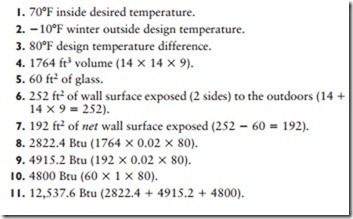Ventilation Heat Loss
In larger structures (e.g., commercial or industrial buildings), ventilation is necessary for both health and comfort. In houses, the amount of infiltrated air is generally sufficient to supply the ventilation requirements.
When ventilation is provided, the heating system warms the out- side air used for this purpose (i.e., ventilation) to the inside design temperature. The heat required will be equivalent to the heat lost by ventilation and can be calculated with the following formula:
H = 0.018 X Q(ti – to)
where
H = heat loss by ventilation.
Q = volume of ventilation air.
0.018 = specific heat of air (0.240) times density of outdoor air (approximately 0.075).
The Average Value Method
Heat loss from a structure can also be calculated by using average values for four basic factors. These four factors and their assigned values are:
1. Wall factor (0.32 Btu)
2. Contents factor (0.02 Btu)
3. Glass factor (1 Btu)
4. Radiation factor (240 Btu)
Each of these four factors is based on a 1oF temperature difference and must be multiplied by the design temperature difference (see Design Temperature Difference in this chapter) obtained for the structure and its geographical location.
The average value for each factor represents the amount of heat (in Btu) that will pass through 1 square foot of the material in 1 hour. Thus 0.32 Btu will pass through a square foot of ordinary brick wall or through a wall where the average frame construction is used in 1 hour. It should be stressed that these are average values useful in a simple and quick way of calculating heat loss.
The wall factor of 0.32 Btu varies for different kinds of walls, and heat loss calculations based on the use of average values will be only approximately accurate. More precise heat loss calculations can be made by using coefficients of heat transmission (U-factors).
The glass factor (1 Btu) is used to represent the amount of heat that will pass through 1 square foot of glass in an hour.
The radiation factor (240 Btu) was originally used to represent the amount of heat in Btu given off by an ordinary free-standing, cast-iron radiator on the basis of the square-foot area of heating surface per hour under average conditions. The average value of the radiation factor was based on repeated test observations that the amount of heat given off by ordinary cast-iron radiators per degree difference in temperature between the steam (or water) in the radiator and the air surrounding the radiator is about 1.6 Btu per square foot of heating surface. Taking this as a basis, a steam radiator under 21⁄2 lb pressure corresponds approximately to 220°F; when surrounded by air having a 70°F inside air temperature, it gives off heat at a rate of 240 Btu (220 – 70 X 1.6 = 240 Btu).
Radiators became so varied in design (with corresponding variations in the sizes of heating surface areas) that it became necessary to regard 240 Btu as a standard value.
Hot-water heating systems are planned on the basis of the Btu per hour capacity of each emitting unit. In steam heating systems, the radiation to be used is selected on the basis of the square foot EDR (equivalent direct radiation) capacity of each unit. One square foot of EDR equals 240 Btu/h. The EDR capacity of a space is expressed in square feet and may be determined by dividing the total heat required (expressed in Btu/h) by 240. For example, a room requiring 12,000 Btu/h to heat it would have a steam radiation requirement of 50 ft2 EDR capacity.
The steps involved in determining heat loss with the average value method are:
1. Decide upon the desired inside air temperature.
2. Obtain the winter outside design temperature of the location of the structure from published lists or a local weather bureau.
3. Determine the design temperature difference (the difference between the temperatures found in Steps 1 and 2).
4. Calculate the volume of the structure or space.
5. Calculate the total area (in square feet) of window glass.
6. Calculate the total area of wall surface exposed to the outdoors.
7. Deduct the total area of window glass (Step 5) from the total area of wall surface exposed to the outdoors (Step 6).
8. Multiply the volume of the structure or space (Step 4) by the contents factor (0.02) to determine the Btu required to raise the temperature of the volume an amount equal to the design temperature difference (Step 3).
9. Multiply the net wall surface area (Step 7) by the wall factor (0.32) to determine heat loss through the walls.
10. Multiply the total window glass surface area (Step 5) by the glass factor (1) to determine heat loss through glass.
11. Add the figures obtained in Steps 8 to 10 to obtain the total heat loss per hour for the structure or space (this is equal to the total heat required per hour).
The 11 steps outlined above might be more clearly understood if shown in a sample problem.
Let’s assume that you must calculate the heat loss for a space 14 ft wide X 14 ft long X 9 ft high, and that 60 ft2 of window glass is equally divided between two exposed walls. The inside desired temperature is 70°, and the winter outside design temperature is
-10°F. Your procedure (corresponding step by step to those out- lined above) is as follows:
